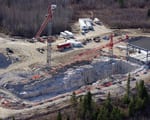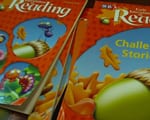Stump’s work in underground nuclear explosion monitoring is significant in support of the Comprehensive Nuclear-Test-Ban Treaty
SMU seismologist Brian Stump has been named an American Association for the Advancement of Science (AAAS) Fellow for distinguished contributions to his field, particularly in the area of seismic monitoring in support of the Comprehensive Nuclear-Test-Ban Treaty.
AAAS is the world’s largest general scientific society and publisher of the journal Science. Stump, Albritton Chair of Geological Sciences in the Roy M. Huffington Department of Earth Sciences in SMU’s Dedman College, is the fifth professor at Southern Methodist University to be recognized as an AAAS Fellow.
“Dr. Stump is a scientist of the first rank and brings the results of his outstanding research into the classroom, where his students benefit from his example and insights as a scholar,” said SMU President R. Gerald Turner. “He richly deserves the AAAS recognition by his peers and we are proud that he calls SMU home.”
Stump is well known regionally for his continued work researching the increase of small earthquakes that have been occurring in North Texas since 2008.
But his work in detecting ground motion from explosions has for more than 20 years proved invaluable to the United States government in ensuring that the world’s nuclear powers abide by their agreements related to underground nuclear testing.
“Brian’s work has been seminal in scientists’ ability to rapidly and accurately discern the difference between an earthquake, a conventional explosion — such as might occur in a mining accident — and a nuclear test,” said James E. Quick, SMU vice president for research and dean of graduate studies. “His research is tremendously important to all of us, and yet he is equally committed to teaching and serving as a mentor to young faculty.”
Stump served as scientific adviser to the U.S. delegation to the Conference on Disarmament from 1994 through 1996 and continues to be called upon frequently to assist the U.S. government in the interpretation of seismic and acoustic data.
“I’m humbled by the recognition by the AAAS that science impacts the society in which we live,” Stump said. “I really believe that. And the work we’ve done at SMU on inducted seismicity in North Texas has that same blend of real science and societal impact.”
For the last five years Stump has chaired the Air Force Technical Applications Center Seismic Review Panel, which provides a review of federally funded efforts in nuclear monitoring. He served as a committee member on the National Academy of Sciences Committee on Seismology and Continental Dynamics from 2007 through 2012, and recently completed a term as board chair for Incorporated Research Institutions for Seismology (IRIS), a consortium of more than 100 universities funded by the National Science Foundation.
Stump joined SMU in 1983 from the Seismology Section of the Air Force Weapons Laboratory at Kirtland Air Force Base in New Mexico. He graduated summa cum laude from Linfield College in McMinnville, Ore. with a bachelor of arts in physics in 1974, received a master of arts from the University of California at Berkeley in 1975 and received his Ph.D. in geophysics from the University of California at Berkeley in 1979 after completing a thesis titled Investigation of Seismic Sources by the Linear Inversion of Seismograms.
SMU faculty previously named as AAAS Fellows are James Quick, volcanologist and research dean, who was named a Fellow in 2013; environmental biochemistry scholar Paul W. Ludden, SMU provost and vice president for academic affairs and a professor in the Department of Biological Sciences, who was named a Fellow in 2003; anthropologist David J. Meltzer, Henderson-Morrison Professor of Prehistory in the Department of Anthropology who was named a Fellow in 1998; and James E. Brooks, provost emeritus and professor emeritus in the Roy M. Huffington Department of Earth Sciences, who was named a Fellow in 1966.
The AAAS Fellows program began in 1874. AAAS members may be considered for the rank of fellow if nominated by the steering group of their respective sections, by three fellows, or by the association’s chief executive officer. Each steering group then reviews the nominations of individuals within its respective section and forwards a final list to the AAAS Council, which votes on the final list of fellows.
The Council is the policy making body of the AAAS, chaired by the president, and consisting of the members of the board of directors, the retiring section chairs, delegates from each electorate and each regional division, and two delegates from the National Association of Academies of Science. — Kimberly Cobb



 Women have made strides for equality in society, but gender gap still exists in art museum directorships
Women have made strides for equality in society, but gender gap still exists in art museum directorships Search for dark matter covers new ground with CDMS experiment in Minnesota
Search for dark matter covers new ground with CDMS experiment in Minnesota NOvA experiment glimpses neutrinos, one of nature’s most abundant, and elusive particles
NOvA experiment glimpses neutrinos, one of nature’s most abundant, and elusive particles SMU scientists to deploy seismic monitors in North Texas region near Azle, Texas
SMU scientists to deploy seismic monitors in North Texas region near Azle, Texas


 Department of Defense awards $2.6 million to SMU STEM program for minority students
Department of Defense awards $2.6 million to SMU STEM program for minority students
 Observed by Texas telescope: Light from huge explosion 12 billion years ago reaches Earth
Observed by Texas telescope: Light from huge explosion 12 billion years ago reaches Earth Low IQ students learn to read at 1st-grade level after persistent, intensive instruction
Low IQ students learn to read at 1st-grade level after persistent, intensive instruction Richest marine reptile fossil bed along Africa’s South Atlantic coast is dated at 71.5 mya
Richest marine reptile fossil bed along Africa’s South Atlantic coast is dated at 71.5 mya